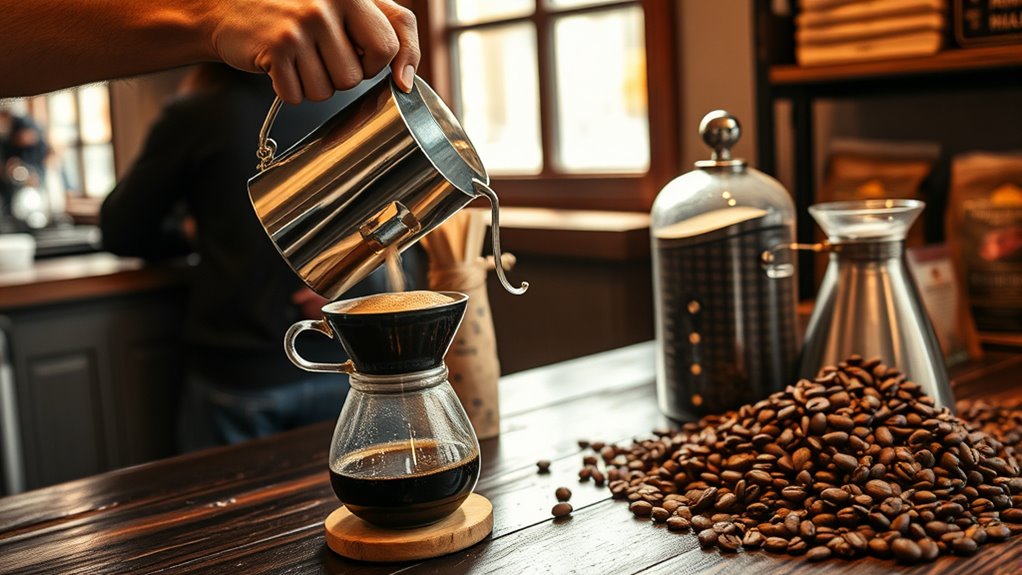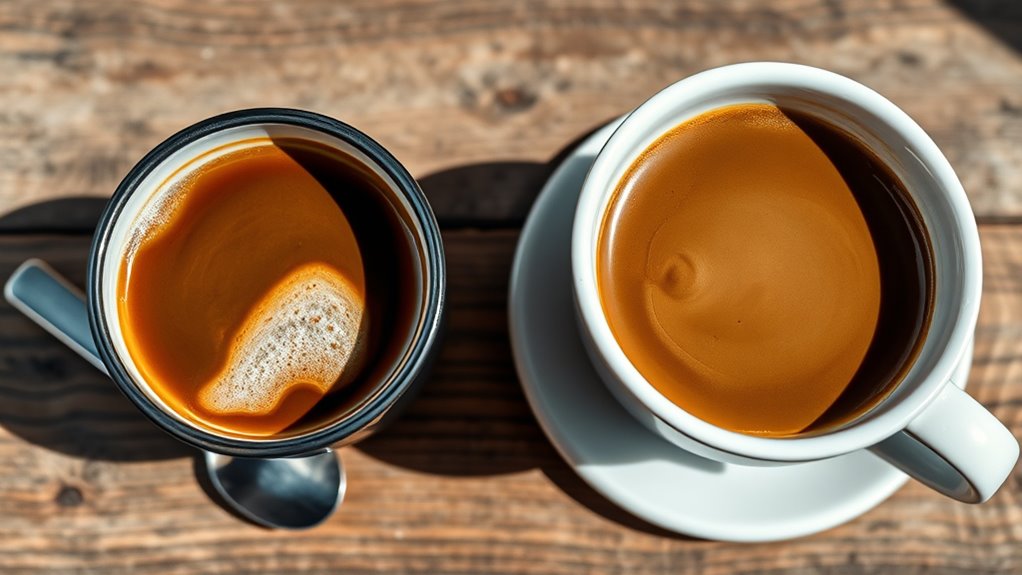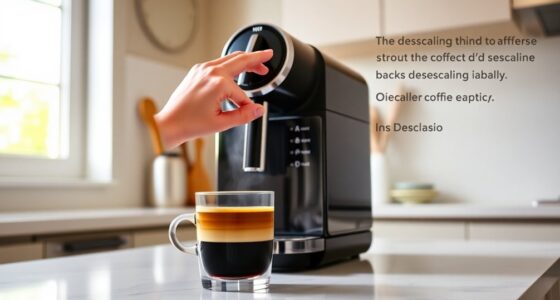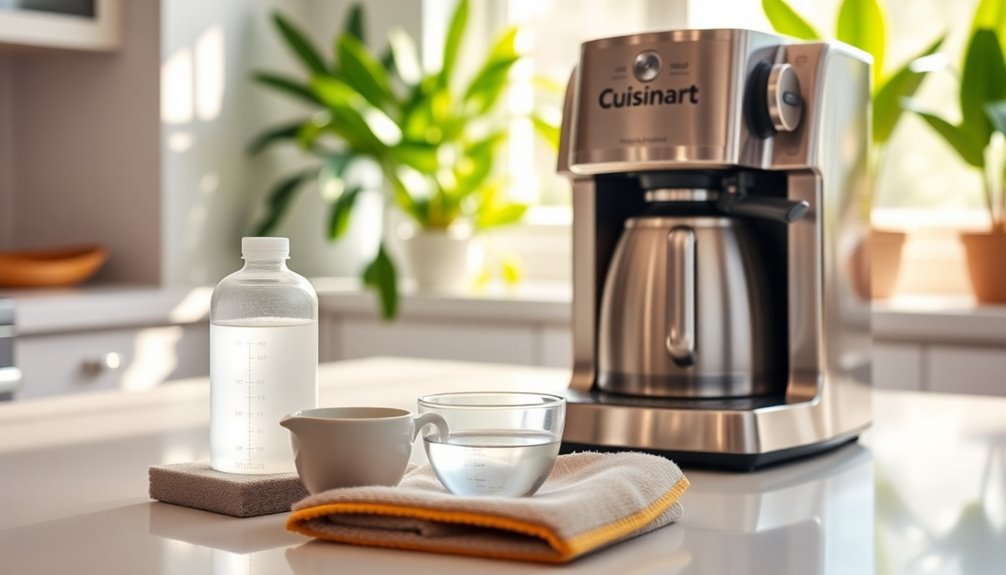In just 10 minutes, you can fine-tune your brewing for better single origin and blend coffees by adjusting grind size, water temperature, and brew time. For single origins, aim for gentle techniques like pour-over or AeroPress to highlight delicate floral and fruity notes. For blends, focus on methods like drip or espresso for smooth, full-bodied flavors. Small tweaks make a big difference—keep exploring to discover even more flavor potential in each cup.
Key Takeaways
- Adjust water temperature and grind size based on whether brewing single origin or blend to enhance desired flavors.
- Use pour-over for single origin to highlight subtle regional nuances; opt for drip or espresso for blends to promote balance and richness.
- Fine-tune brew time: shorter for delicate single origins, longer for full-bodied blends to optimize extraction.
- Experiment with slight tweaks in variables to reveal complex notes in single origin or smoothness in blends within 10 minutes.
- Consistently apply tailored techniques to consistently highlight the unique qualities of each coffee type in just 10 minutes.
Optimizing Brewing Techniques for Single Origin and Blends

Choosing between a single origin and a blend can considerably impact your coffee experience, but often, the difference isn’t as clear-cut as it seems. Your decision hinges on understanding how brewing techniques influence coffee flavor profiles and what you’re aiming for in each cup. Single origin coffees highlight the unique characteristics of a specific region, often offering complex, nuanced flavors. In contrast, blends combine beans from multiple locations, creating a more balanced, consistent taste. To truly appreciate these differences, you need to adjust your brewing techniques accordingly.
When brewing single origin coffee, you want to emphasize its distinct qualities. Many enthusiasts favor pour-over or AeroPress methods because they provide precise control over variables like water temperature, grind size, and brew time. These techniques help extract the subtle floral, fruity, or earthy notes that define the coffee’s origin. For example, a light roast from Ethiopia might reveal bright citrus and jasmine aromas when brewed with a pour-over, showcasing its vibrant coffee flavor profile. On the other hand, a darker roast from Central America might benefit from a French press, which emphasizes body and richness, maintaining the coffee’s bold, caramel undertones.
Blends, on the other hand, often aim for consistency and harmony. Since blends are crafted to balance different beans’ strengths, you might prefer brewing methods that emphasize smoothness and full-bodied flavors. Drip coffee makers can be an excellent choice here, providing a reliable extraction that highlights the blend’s overall profile. If the blend contains beans with varying roast levels, experimenting with brew time can help you find that sweet spot—long enough to extract the full spectrum of flavors without bitterness. Some people also enjoy espresso for blends, as it intensifies the richness and can bring out the nuanced layers of the combined beans.
Ultimately, understanding your preferred coffee flavor profiles is key. If you love discovering complex, regional nuances, investing time in tailored brewing techniques for single origin beans makes sense. If you prefer a consistent, balanced cup, then optimizing your method for blends ensures you get the most out of each brew. A quick tune-up in your brewing approach—adjusting grind size, water temperature, or brew time—can dramatically transform your experience. Remember, the right technique doesn’t just reveal the coffee’s flavor profile; it makes the whole drinking experience more enjoyable. So, whether you’re exploring single origins or perfecting your blend brew, small adjustments will help you taste the full potential of your coffee.
Frequently Asked Questions
How Do Grind Size Differences Impact Flavor Extraction?
Grind size considerably impacts flavor extraction by influencing grind consistency. A finer grind exposes more surface area, enhancing extraction and resulting in stronger, more intense flavors. Conversely, a coarser grind produces a gentler extraction, highlighting different flavor profiles. Adjusting grind size allows you to control flavor extraction, balancing bitterness and acidity, and tailoring your coffee to your preferred taste. Consistent grind size ensures an even extraction, delivering a better overall flavor experience.
Can Water Temperature Adjustments Enhance Both Single Origin and Blends?
They say “you are what you drink,” and adjusting water temperature does enhance both single origin and blends. By tweaking water chemistry, you influence taste profiles, extracting different flavors more effectively. Hotter water generally boosts extraction of complex notes, while cooler water can highlight delicate flavors. Experimenting with temperature helps you fine-tune your brew, ensuring each cup reflects your preferred flavor profile—whether it’s a vibrant single origin or a balanced blend.
What Role Does Brew Time Play in Balancing Flavors?
Brew time plays a vital role in balancing flavors in your coffee. If you brew too short, you might miss out on extracting full flavor, resulting in a sour or weak taste. Conversely, too long, and the coffee can become bitter or over-extracted. Adjusting your brew time helps you find that sweet spot, ensuring a well-rounded flavor balance that highlights the unique qualities of your single origin or blend.
Are There Specific Brewing Methods Better Suited for Single Origin?
You’ll find pour-over and AeroPress are ideal for single origin beans because they preserve freshness and highlight unique flavor profiles. These methods offer precise control over brewing variables, ensuring fresh beans shine through. Studies show that single origin brews retain more nuanced flavors when brewed quickly and at specific temperatures, making these techniques perfect for appreciating the distinct characteristics that set single origins apart from blends.
How Can I Troubleshoot Common Over- or Under-Extraction Issues?
To troubleshoot over- or under-extraction, start by adjusting your brewing equipment, such as grind size and brew time. If your coffee tastes sour or weak, try a finer grind or longer brew. If it’s bitter or dull, go coarser or shorten the brew. Consistently monitor these changes to maintain flavor consistency, ensuring your equipment settings match your beans, whether single origin or blend, for ideal extraction.
Conclusion
Now that you’ve unbarred these quick, powerful tweaks, your coffee game is about to change. But here’s the twist—you might find yourself craving even more perfection, exploring new variables and secret techniques. Will a simple adjustment reveal a hidden flavor you never knew existed? Keep experimenting, stay curious, and the perfect cup might just be a brew away. The journey to better coffee isn’t over—it’s only just beginning. Are you ready to take it to the next level?










